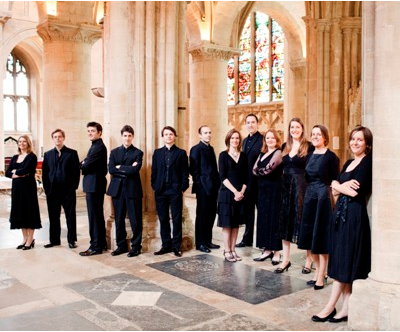It isn’t that each of the six King’s Singers has an unusual voice, just a beautiful one. It’s the combination of this matched set of men’s voices singing together — with the impeccable intonation, the purity of tone, the expressiveness each one brings — that makes hearing the group an extraordinary experience.
This was borne out at the Early Music Guild’s sold-out Town Hall concert Saturday night, when the group gave a performance titled “Triumphs: Renaissance Conquests of Love and War.” It was an applicable title.
The first half included six pairs of madrigals from the late 16th to early 17th centuries from Italy and England: the Italian from Il Trionfo di Dori—madrigals commissioned in praise of a bride, Elisabetta Zustinian—and the English from The Triumphs of Oriana, a similar collection inspired by the former, this one in praise of another Elizabeth, Queen of England.
Together, the composers made up a who’s-who of many of the great madrigal writers of those two countries at a time when its form flourished, including Gabrieli, Striggio, and Palestrina on the Italian side; Morley and Weelkes on the English. Given their intent, all twelve of these madrigals are high-falutin’ pastoral descriptions of nymphs and shepherds singing praises.
Madrigals aren’t long, and the beauty of each of these lies in the individual lines woven like threads in a tapestry, each perfect in itself, but making up the greater whole together. Where The King’s Singers excel is the exact balance of those threads, each with its own color, and since they sing this music without vibrato, the harmonic intervals are clean and thus brighter.
The second half of the concert came down to earth with a bump, much earthier songs bracketed by two narrative chansons from Janequin, “Les Cris de Paris” and “La Guerre.”
In “Les Cris” the singers created the hawkers’ sometimes raucous competition for buyers, not diminished by a siren on a nearby street which just added to the ambience. In “La Guerre,” they were the entire battle — soldiers exhorting each other, fife and drummers building the excitement, cannon and bombardiers and at the end, triumph one side, defeat the other.
In between came songs which could have expressed the amorous dalliance by either soldiers or hawkers, much more down to earth than the madrigals, and just one gorgeous little song capturing the ambience of Paris.
The King’s Singers — two countertenors, one tenor, two baritones and a bass — started its existence in 1968, named from all of them being choral scholars in the famed choir of King’s College, Cambridge. The longest tenure in the group as of now is countertenor David Hurley, who has been with it since 1990, and the most recent, bass Jonathan Howard who has only been a Singer since 2011.
For this concert, the group stood in a shallow arc, with flat-topped music stands just above waist level. While what a group wears is rarely relevant in a review, it’s rare to see six men performing in identical sartorially elegant suits which appeared tailormade for each one, with identical ties and shirts. It’s also unusual that they all stood in the same stance, their hands, when not turning a page, clasped at waist level. The effect tended to keep distraction at a minimum, at least until the second half, when particularly tenor Paul Phoenix produced a most expressive pair of shoulders and knees, not to mention his face and head.
The enthusiastic audience brought them back, at which time one shed a tie, another a coat and they settled down to a game of cards (poker maybe?), at a miraculously produced cloth-covered table singing one more Italian song, then finishing standing in close order like a pop group answering a special request, a greeting for an audience couple’s new grandchild, with “You Are the New Day.” It was just as exquisitely sung, as spellbinding, as everything that had gone before.
They said they’ll be back here next December. Up next from the Early Music Guild is a visit from Tafelmusik, which Gramophone has called “one of the world’s top baroque orchestras.”

